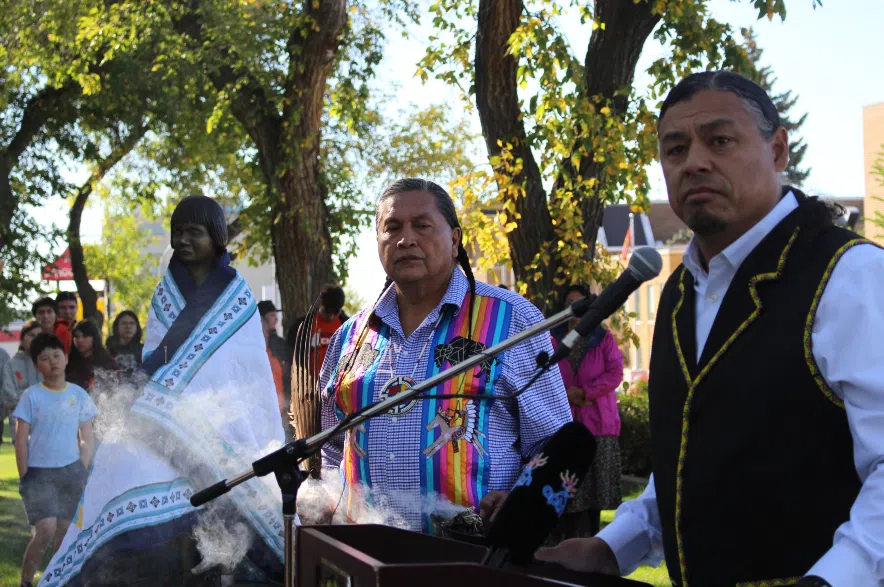At the entrance to a grassy grove in Central Park in North Battleford, a little girl stood on a boulder wrapped in a star blanket. As the mid-morning sunlight gently dappled the leaves of the overhanging trees in gold, the girl — no older than seven — maintained a serene expression on her sculpted bronze face.
Now, 110 years after the Battleford Industrial School — Canada’s first federally funded residential school closed — former student Annie Peyachew has taken her place in the Saskatchewan city as a symbol of hope.
“It’s very emotional today, but I’m very happy at the same time,” said sculptor and Annie’s relative Lionel Peyachew.
The artist, a member of Red Pheasant Cree Nation, explained that he never expected Friday’s event to draw so many people.
“It just shows me that everybody … still truly believes in a way of hope and resilience.”
Read more
- First Nations, Inuit and Metis leaders say work lays ahead on road to reconciliation
- Hundreds walk in Regina to honour victims, survivors of residential schools
- Eight potential graves found near former George Gordon residential school

The bronze statue of Annie Peyachew wrapped in a star blanket was unveiled in Central Park in North Battleford on Sept. 27, 2024. (Julia Lovett-Squires/battlefordsNOW Staff)
The work was commissioned four years ago by the Battlefords Industrial School Commemorative Association (BISCA) from federal funds allocated for “Commemorating the History and Legacy of Residential Schools.”
Clay work for the statue, which stands just over four feet tall, took six months and then another six to eight months to complete in a foundry.
Gathered at the park were local dignitaries, elders, chiefs and family of the young girl, who died in 1911. Also, in attendance and scattered in clusters on the grass were school children, who gazed up at the small girl on the rock.
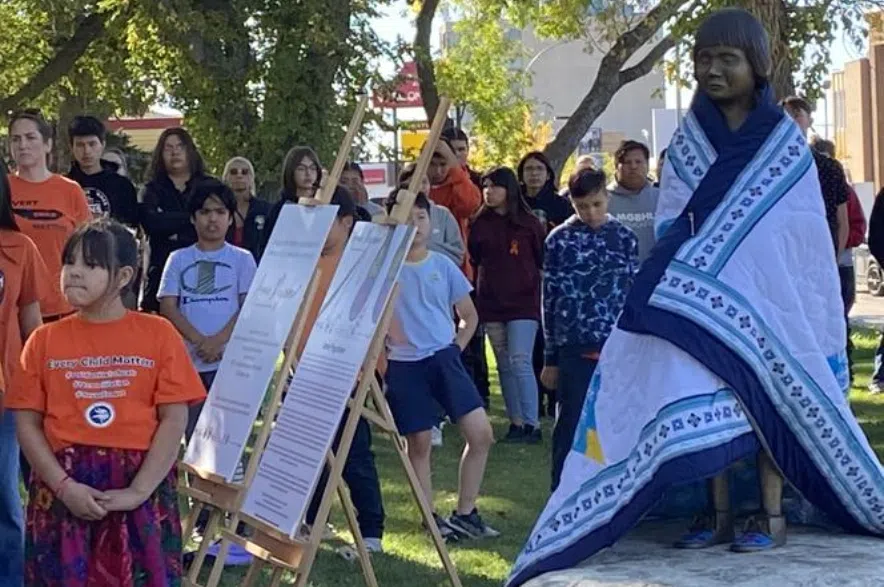
A child of the past stands with the children of the future during the presentation of a bronze statue of Annie Peyachew in Central Park in North Battleford on Sept. 27, 2024. (Julia Lovett-Squires/battlefordsNOW Staff)
Standing in her moccasin-clad feet while smoke from a smudge pan’s smouldering contents washed over her, this child of the past stood among the children of the future.
“We are here, ladies and gentlemen for something that’s very special and something that’s going to be everlasting in our community,” said emcee Shelden Wuttunee, referring to the commemoration of the memory of a loved one.
“Learning about the true history, moving towards a better relationship and righting the wrongs of the past.”
While addressing the children in attendance, Wuttunee said it was “a beautiful sight” to see them sitting together on their Treaty 6 land at a gathering to share in remembering all who attended residential schools around the world.
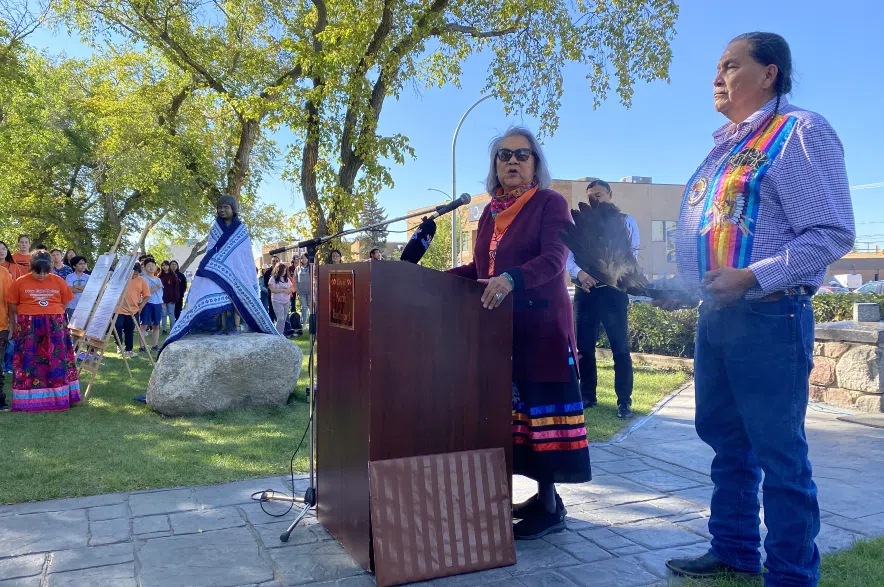
BISCA member Alvin Baptiste listens as Senator Jenny Spyglass speaks to the children during the presentation of a bronze statue of Annie Peyachew in Central Park in North Battleford on Sept. 27, 2024. (Julia Lovett-Squires/battlefordsNOW Staff)
Calling upon Federation of Sovereign Indigenous Nations (FSIN) Senator Jenny Spyglass to come up to the podium and share a few words, she too addressed the students.
Spyglass, whose mother was a Peyachew and thus is a relative of the girl who inspired the work of art, spoke about her own experience as a survivor.
“I was just a baby when they took me away,” said the former Chief of Mosquito Grizzly Bear’s Head Lean Man First Nation.
“Young people, young kids, I want to say this to you: You are our future.”
Spyglass explained it was imperative that they stay in school and get an education as it was important for everyone, and noted she herself continues to learn every day. Part of that education was learning who she was.
“I’m a Stoney-Assiniboine, my dad was Assiniboine, I lost my language bu, my mom was my way-maker, my mom was my teacher, so with that I talk Cree, and I’m proud of it,” she said.
“I’m proud that I found…my identity. My identity is to go back to my culture, my culture is real to me wherever I go.”
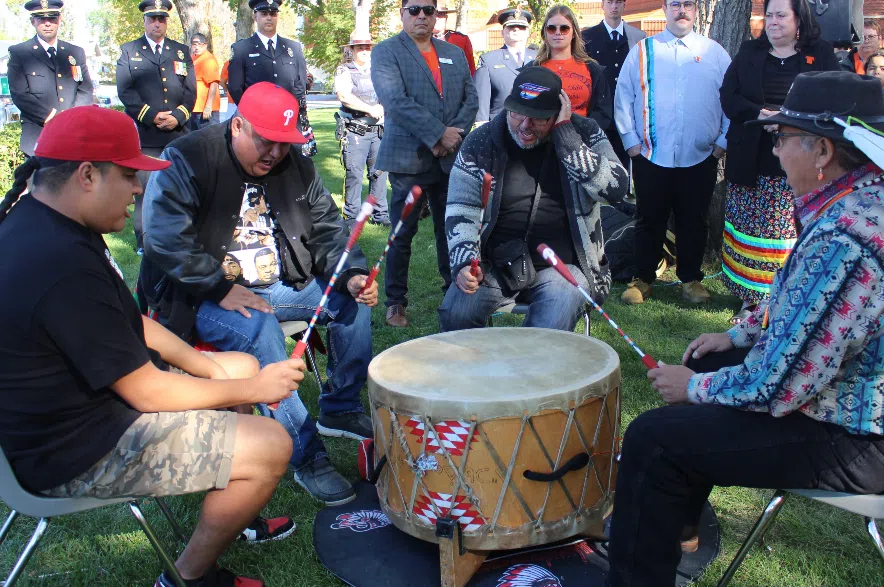
Drummers and singers opened ceremonies for the presentation of a bronze statue of Annie Peyachew in Central Park in North Battleford on Sept. 27, 2024. (Julia Lovett-Squires/battlefordsNOW Staff)
According to BISCA Member Sherron Burns, it was the responsibility of everyone to acknowledge and learn the history of the country — including the dark chapters of the residential schools and their legacy.
“Today is also about reconciliation. Reconciliation moves us to action. Today, we remember and honour the children of residential schools,” she said.
“Today I remember Annie Peyachew: student number 0139.”
Finally, the moment came for the artist, with the help of Lieutenant Governor Russ Mirasty, to remove the blanket from the child’s shoulders.
“It is indeed a fitting time for this statue as we near National Day for Truth and Reconciliation and Orange Shirt Day,” said Mirasty.
“From today, this powerfully evocative sculpture will stand as a reminder of residential schools but much more than that.”
Earlier in the day and looking at the statue still wrapped in the star blanket, the second-generation residential school survivor grew emotional. Mirasty explained his mother went to two separate schools before he followed in the early 1960s to the Prince Albert Indian Residential School.
“It does really evoke those things that — that sometimes — sometimes you want to keep hidden,” he said.
“I know that it’s important for all of us to make sure that we continue to talk about the history of the schools…and this beautiful statue here will remind us each and every day of that history, but also of the hope that exists in the future.”
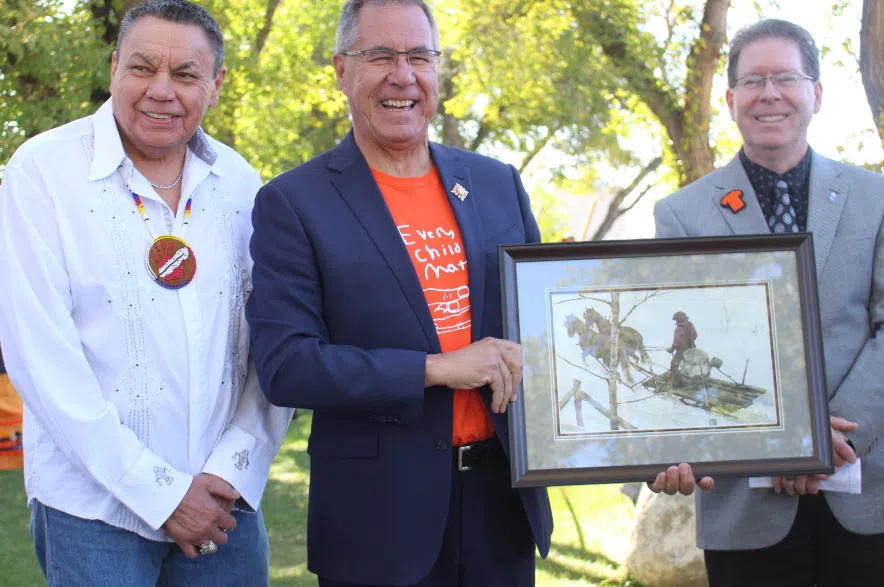
Artist Lionel Peyachew (left) and North Battleford Mayor David Gillan (right) present Saskatchewan Lieutenant Governor Russ Mirasty (centre) with a piece of art by Allen Sapp at the presentation of a bronze statue of Annie Peyachew in Central Park in North Battleford on Sept. 27, 2024. (Julia Lovett-Squires/battlefordsNOW Staff)
It was for that reason Central Park was chosen as the location for the statue — the visibility in the heavy traffic area would offer maximum effect.
Eleanore Sunchild, BISCA member, explained the event and the statue meant “a lot.”
“It’s such a beautiful day and the statue is so meaningful,” she said, noting that while Annie stands for all the children who didn’t come home, she also stands for the survivors and their families.
Sunchild said there was a reason the city was called “Crimetown.”
Much of the population, she explained, had that history and generational trauma in their families. She said the only way the community can heal is through working together, education and looking for ways to support Indigenous people.
“It’s a statement piece. It’s a statement piece for the Battlefords about reconciliation and acknowledging the dark past,” she said.
“It’s also about healing and working together so that we can build a future.”
Mayor David Gillan concurred with Sunchild, and added that as mayor, he wanted events like this to bring people together to learn from the past so they may move forward together. He explained facing the truth is part of that process.
“Then there’s the reconciliation, how do we go forward together, how do we really become a unified community?” he asked.
One way was holding activities throughout the week leading up to Sept. 30, but he said he also hoped the other 51 weeks in the year offer similar chances.
“That’s part of healing, I think, especially for a lot of our community members who have suffered and are still suffering from the legacy,” he said.
“It’s really an understanding and empathy for others.”
Meanwhile, as the artist reflected on the events of the day, and saw the sunlight cast the back of the little girl in a sparkling glow, it gave him a sense of satisfaction.
“She was lost, and nobody knew how she ever died,” he said, noting it was good for a sculpture like the one that depicted his Kokum to be in the community.
“People can come and reflect and also to celebrate things like Orange Shirt Day and Truth and Reconciliation Day and stuff like that, so I’m very honoured.”
Read more
- First Nations, Inuit and Metis leaders say work lays ahead on road to reconciliation
- Hundreds walk in Regina to honour victims, survivors of residential schools
- Eight potential graves found near former George Gordon residential school
